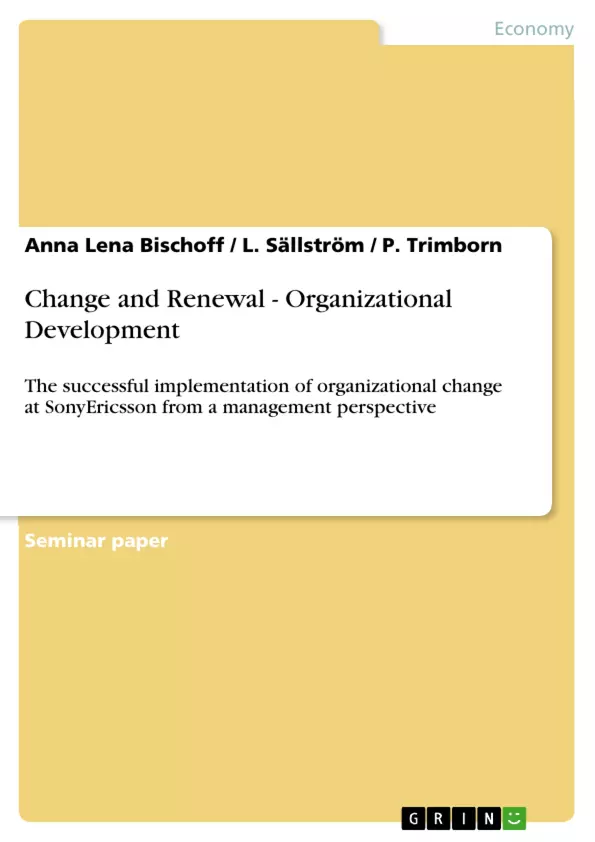In the late 1990’s Ericsson faced major problems, selling their products to customers. Ericsson experienced a crash from being the market leader to rock bottom. To save Ericsson’s reputation, they needed to find a solution to their problem to survive in the market. Therefore Ericsson’s approach was to look for a company, which would provide the expertise, they lacked. They found an equal partner in Sony and built a Joint Venture with them. However, success is not automatically guaranteed when joining forces with another company. Success is a question of many aspects.
The change and turnaround at Ericsson is described in this work. Furthermore is the sucess of the change discussed, using theoretical models from the works of French/Bell "Organizational Development": The Congruence Model and The Litwin/Burke Model. Furthermore the approach of Innovative Organizations was used as well as Jackson/Carter's "Rethinking Organizational Behaviour" approach on Semiotics, Power and Knowledge.
Inhaltsverzeichnis (Table of Contents)
- Summary
- Introduction
- Backround
- Research question
- Methods
- Theory
- Overview Organizational Development
- The Congruence Model
- The Litwin Burke Model
- Rafferty and Restebog's approach on change
- Research frontier - Organizational Development
- Innovative Organization
- Overview - Innovative Organizations
- Innovative Organizations - creation and processes of innovation
- Summary
- Description
- Decsription of Ericsson
- Description of the change situation
- Interpretation
- The situation prior to the merger
- The Congruence Model – Diagnosis of the situation at Ericsson
- The situation during the merger
- The Litwin and Burke Model - the change process at Ericsson
- Rafferty and Restebog – the impact of change on the staff at Ericsson
- Interpretation - Conclusion
- The situation prior to the merger
- Re-Interpretation
- Re-Interpretation - Innovative Organizations
- Re-Interpretation - Jackson and Carter
- Overview Jackson and Carter
- Semiotics
- Knowledge
- Power
- Conclusion
- References
- Books
- Articles
- Internet sources
- List of figures
- Appendix
- Explanation of terms used
- Interview
- Interview questions
- Interview with K.A. A., 17.11.2010
Zielsetzung und Themenschwerpunkte (Objectives and Key Themes)
This research paper analyzes the successful implementation of organizational change at SonyEricsson, focusing on the merger between Sony and Ericsson from a management perspective. It aims to understand how change was managed and what factors contributed to its success or failure. The paper draws upon various theoretical models of organizational development, including the Congruence Model, the Litwin and Burke Model, and Rafferty and Restebog's approach, to interpret the situation and identify key challenges and opportunities.
- The impact of organizational change on a company facing market challenges.
- The effectiveness of different organizational development models in facilitating mergers and acquisitions.
- The role of culture, leadership, and communication in driving successful organizational change.
- The importance of employee engagement and motivation in achieving organizational goals.
- The impact of innovation and knowledge sharing on a company's ability to adapt to changing market dynamics.
Zusammenfassung der Kapitel (Chapter Summaries)
- Summary: Provides an overview of the research paper, highlighting the key findings and conclusions regarding organizational change at SonyEricsson.
- Introduction: Introduces the research topic and provides context by discussing the increasing need for organizations to adapt to rapid changes. The background of Ericsson's challenges in the late 1990s and their decision to merge with Sony is discussed, setting the stage for the research question.
- Methods: Outlines the research methodology used in the paper, specifically focusing on the analysis of organizational development at Ericsson using the Litwin and Burke Model, the Congruence Model, and the concept of Innovative Organizations. It also describes the approach by Jackson and Carter and explains how these theories are applied to the case of Ericsson.
- Theory: Introduces various theoretical frameworks that guide the analysis of organizational change. It includes a detailed overview of the Congruence Model, the Litwin and Burke Model, and Rafferty and Restebog's approach. This section also explores the research frontier of organizational development and the concept of innovative organizations.
- Description: Provides a detailed description of Ericsson's situation before and after the merger with Sony. This includes a description of the company's challenges in the market and the specific change situation created by the merger.
- Interpretation: Analyzes the change situation at Ericsson using the theoretical frameworks introduced in the "Theory" section. It examines the situation prior to the merger using the Congruence Model, and then analyzes the merger process using the Litwin and Burke Model and Rafferty and Restebog's approach. This chapter aims to understand the challenges and opportunities presented by the merger and its impact on employees.
- Re-Interpretation: Revisits the findings from the "Interpretation" chapter and applies the perspective of Innovative Organizations and Jackson and Carter's critical view on organizational processes. This section explores how these theoretical frameworks can shed additional light on the complexities of the change situation at Ericsson.
Schlüsselwörter (Keywords)
This research paper focuses on organizational development, organizational change, mergers and acquisitions, corporate culture, leadership, communication, employee engagement, innovation, knowledge sharing, and the impact of change on organizational members. It examines these concepts through the lens of theoretical models such as the Congruence Model, the Litwin and Burke Model, Rafferty and Restebog's approach, and the concept of Innovative Organizations.
- Quote paper
- Anna Lena Bischoff (Author), L. Sällström (Author), P. Trimborn (Author), 2010, Change and Renewal - Organizational Development, Munich, GRIN Verlag, https://www.grin.com/document/163017



